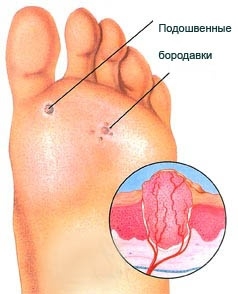Plantar warts cause pain when walking, as they are constantly injured and compacted. Warts on the feet are often confused with calluses, but this benign skin growth is viral in nature and is distinguished by the presence of a root that goes deep into the skin. It is the presence of such a root and viral origin that makes the treatment or removal of warts by folk methods almost meaningless. On the contrary, traumatizing a wart on the legs can lead to the spread of the virus and the appearance of a number of new warts. Read about the most effective methods of dealing with plantar warts on Estet-portal.com.
Why do warts appear on the legs and what do they look like
A plantar wart occurs as a result of the activation of the papillomavirus, which occurs, as a rule, due to the weakening of the body's defenses. You can catch papillomavirus in baths, saunas, swimming pools, gyms, since this infection is spread by contact. The following factors contribute to the activation of the virus and the development of warts on the legs:
- foot hyperhidrosis;
- uncomfortable shoes;
- foot deformities (flat feet, arthritis);
- diseases associated with impaired blood supply to the lower extremities (varicose veins, diabetes mellitus);
- foot skin injury.
The plantar wart looks like a hard, keratinized formation of a flat, rounded shape, slightly elevated above the surface of the skin, pink or light brown in color. Without treatment, warts on the legs gradually become covered with horny layers and acquire a yellowish tint. Sometimes black dots are visible on the surface – thrombosed capillaries. If many new ones appear next to a single plantar wart, this indicates the activation of the papillomavirus. Sometimes it happens that warts on the legs disappear on their own. But most often, due to constant injury when walking, the plantar wart thickens and causes pain when pressure is applied to it with shoes.
Diagnosis of warts on the legs and features of their treatment
In order to distinguish warts on the legs from other skin neoplasms, you need to scrape off the top of the layers of the epithelium and perform dermatoscopy. If the decision is made to remove the plantar wart, an ultrasound examination of the neoplasm is recommended to determine the depth of penetration of its root into the skin.
 The best results in the removal of warts on the soles of the feet show laser and radio wave methods. They allow you to regulate the depth of penetration, coagulate blood vessels and prevent the spread of the virus from the area of wart removal. If the depth of penetration of the wart is small, cryodestruction or electrocoagulation can be used, but these techniques leave scars after the removal of warts.
The best results in the removal of warts on the soles of the feet show laser and radio wave methods. They allow you to regulate the depth of penetration, coagulate blood vessels and prevent the spread of the virus from the area of wart removal. If the depth of penetration of the wart is small, cryodestruction or electrocoagulation can be used, but these techniques leave scars after the removal of warts.
Preventing the development of warts on the feet depends on foot hygiene and the use of special corrective devices for deformed feet to avoid permanent injury to the sole.









Add a comment